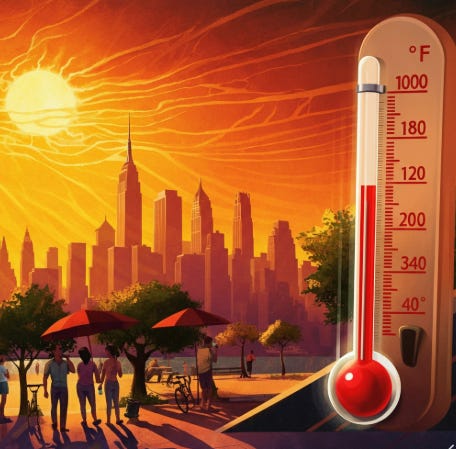Scorching Heat Wave Hits the East Coast: What You Need to Know
Life-threatening record temperatures grip millions as communities battle the impacts—and highlight the urgent need for climate resilience.
The East Coast is experiencing its first major heat wave of the season, and it’s shaping up to be a life-threatening event. With temperatures soaring into triple digits and heat indexes surpassing 100 degrees across vast regions, millions find themselves grappling with sweltering conditions. Cities from Texas to Maine—including major hubs like Boston, New York City, Philadelphia, Baltimore, and Washington, D.C.—are under extreme heat warnings and advisories.
Today marks the peak of this heat wave, with actual temperatures and the heat index threatening to break records. Residents in impacted areas are urged to take extra precautions to avoid heat-related illnesses as communities and infrastructure alike struggle to cope.
Record-Breaking Temperatures and Widespread Impact
Tuesday has proven to be the hottest day for cities across the Northeast. The heat index—factoring in humidity—reached a staggering 106 degrees in Boston and Philadelphia, 102 degrees in New York City, and 109 degrees in Washington, D.C. Other areas in the Southeast, including Charlotte, North Carolina, and Charleston, South Carolina, aren’t faring much better, with "feels-like" temperatures surpassing 105 degrees.
Major cities like Philadelphia, Baltimore, and Raleigh, North Carolina, shattered daily temperature records on Monday, reaching highs not seen in years. The urban heat effect, where cities retain substantially more heat due to concrete and the lack of greenery, has amplified the dangerous conditions.
Upstate New York and even areas of southern New England—places typically known for milder summers—are also enduring these extreme conditions, with heat indexes reaching 102 degrees.
Preparing for the Heat Wave and Mitigating Impacts
To combat the heat, local governments are urging residents to conserve energy and limit strain on electric grids. New York City’s Con Edison has asked residents to reduce their use of energy-intensive appliances during peak hours to avoid outages. This type of heat, which offers little cooling relief overnight, exacerbates vulnerabilities for people living without adequate cooling systems, including older adults and residents in underserved areas.
Extreme heat events also place immense pressure on infrastructure, from energy grids to healthcare systems. During such times, it’s essential for entire communities to come together and ensure safety for all.
Broader Implications of Extreme Heat Events
This heat wave is just one in a series of recurring extreme weather patterns across the globe. Climate experts point to the impacts of global warming, which has increased the intensity, frequency, and duration of heat waves. These events strain infrastructure, harm ecosystems, and disproportionately impact marginalized communities.
Beyond the immediate risks, heat waves highlight the growing need to prioritize climate resilience. Urban planning, investment in cooling infrastructure, clean energy adoption, and increased public awareness play pivotal roles in mitigating heat wave impact. Similarly, national policies tackling greenhouse gas emissions remain critical for long-term solutions.
Staying Safe During Heat Waves
During a heat wave, staying safe is a community and individual effort. Here are some actionable tips to protect yourself and your loved ones:
Hydrate: Drink plenty of water, even if you’re not thirsty, to stay hydrated. Avoid caffeine and alcohol, which can lead to dehydration.
Stay Indoors: Spend time in air-conditioned spaces. If access to air conditioning is limited, visit cooling centers or public facilities like libraries or malls.
Limit Outdoor Activities: Refrain from outdoor exertion during the hottest parts of the day, typically between 10 a.m. and 4 p.m.
Check on Vulnerable Neighbors: Make sure older adults, children, and those with medical conditions have the resources they need to manage the heat.
Use Resources Wisely: Follow local advisories to avoid outages and conserve energy during peak hours.
Building Climate Resilience
Long-term solutions are essential to combat the rising threat of extreme weather, including heat waves. Communities need robust infrastructure, expanded green spaces, and efficient energy systems to reduce urban heat effects. Governments must also prioritize flood mitigation, heat-resistant building designs, and resources for the most vulnerable populations.
Climate change has transformed extreme weather from an anomaly into a regularity. Addressing it requires urgent action on both personal and systemic levels. While communities take immediate steps to protect themselves, this moment reinforces the importance of implementing sustainable strategies to weather these challenges in the years ahead.
Stay cool, stay safe, and advocate for change—our planet and our health depend on it.


